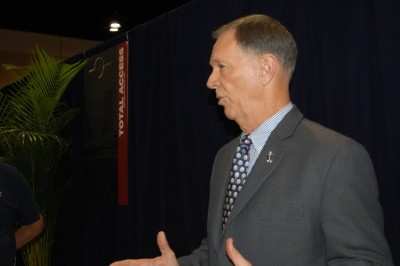Fri, Nov 06, 2009
Calls The Minneapolis Overshoot 'A Very Bad Example'
 FAA Administrator Randy Babbitt said the Flight 188 incident
in which a Northwest jet overflew its intended destination by 150
miles only serves to reinforce his call for an emphasis on
professionalism in the cockpit.
FAA Administrator Randy Babbitt said the Flight 188 incident
in which a Northwest jet overflew its intended destination by 150
miles only serves to reinforce his call for an emphasis on
professionalism in the cockpit.
"The passengers aboard that airplane sat comfortably because
they assumed that the people up front were paying attention,"
Babbitt said in a speech Wednesday to the International Aviation
Club. "Being distracted by compound problems is always a risk in
the cockpit, which is why the captain and the first officer are
trained and professional paid positions. You get paid to be a
professional. That’s actually the definition of the
difference between being a professional and an amateur."
Babbitt said the incident is the symptom of a much bigger
problem. ". I can’t regulate professionalism," he said. "With
everything we know about human factors, there are still those who
just ignore the common sense rules of safety. At the top of the
list is something every pilot has heard over the years from their
flight instructors: Remember to first always fly the airplane."
By contrast, he pointed to the example of US Airways flight
1549, which ditched in the Hudson River after a bird strike with no
loss of life. " There was not one second of less than total
concentration. That crew was the epitome of professionalism and a
textbook case of focus by everyone, including the controllers. That
is an example of being in the game especially when the stakes are
so high. "There was not one second of less than total
concentration. That crew was the epitome of professionalism and a
textbook case of focus by everyone, including the controllers. That
is an example of being in the game especially when the stakes are
so high."
Babbitt told the International Aviation Club that the transition
to NextGen needs to be a cooperative international effort.
"It’s also clear that air traffic modernization can’t
be an intercontinental competition. We have to work together to
make sure that what’s on the drawing board is a good fit for
the system too," he said. "That’s why the goal in our
modernization efforts needs to be in the payoff: NextGen and
SESAR must deliver operational efficiencies. If nothing else, the
dollar cost of fuel, the social cost of carbon and our focus on
being green are proof enough that NextGen and SESAR need to be
hand-in-glove each step of the way. And we are talking with other
authorities around the globe about their plans for the future."

Babbitt emphasized that globalization will play a major role in
the modernization of the air traffic system. "The point is simple,"
he said. "If any of us tries to go it alone, quite clearly,
we’re not going to go as far as we need to. Without
partnership, we simply can’t get there from here.
Globalization of the world is here. Our industry must be in step
with that movement."
More News
The Industry Continues to be Rocked By Some Questionable Operations Recent investigations and a great deal of data has resulted in ANN’s SportPlane Resource Guide’s rep>[...]
Make Sure You NEVER Miss A New Story From Aero-News Network Do you ever feel like you never see posts from a certain person or page on Facebook or Instagram? Here’s how you c>[...]
Visual Approach Slope Indicator (VASI) An airport lighting facility providing vertical visual approach slope guidance to aircraft during approach to landing by radiating a directio>[...]
Airport Marking Aids Markings used on runway and taxiway surfaces to identify a specific runway, a runway threshold, a centerline, a hold line, etc. A runway should be marked in ac>[...]
Aero Linx: The Skyhawk Association The Skyhawk Association is a non-profit organization founded by former Skyhawk Pilots which is open to anyone with an affinity for the A-4 Skyhaw>[...]
 Unfortunate... ANN/SportPlane Resource Guide Adds To Cautionary Advisories
Unfortunate... ANN/SportPlane Resource Guide Adds To Cautionary Advisories ANN FAQ: Turn On Post Notifications
ANN FAQ: Turn On Post Notifications ANN's Daily Aero-Term (04.29.24): Visual Approach Slope Indicator (VASI)
ANN's Daily Aero-Term (04.29.24): Visual Approach Slope Indicator (VASI) ANN's Daily Aero-Term (04.28.24): Airport Marking Aids
ANN's Daily Aero-Term (04.28.24): Airport Marking Aids ANN's Daily Aero-Linx (04.28.24)
ANN's Daily Aero-Linx (04.28.24)




